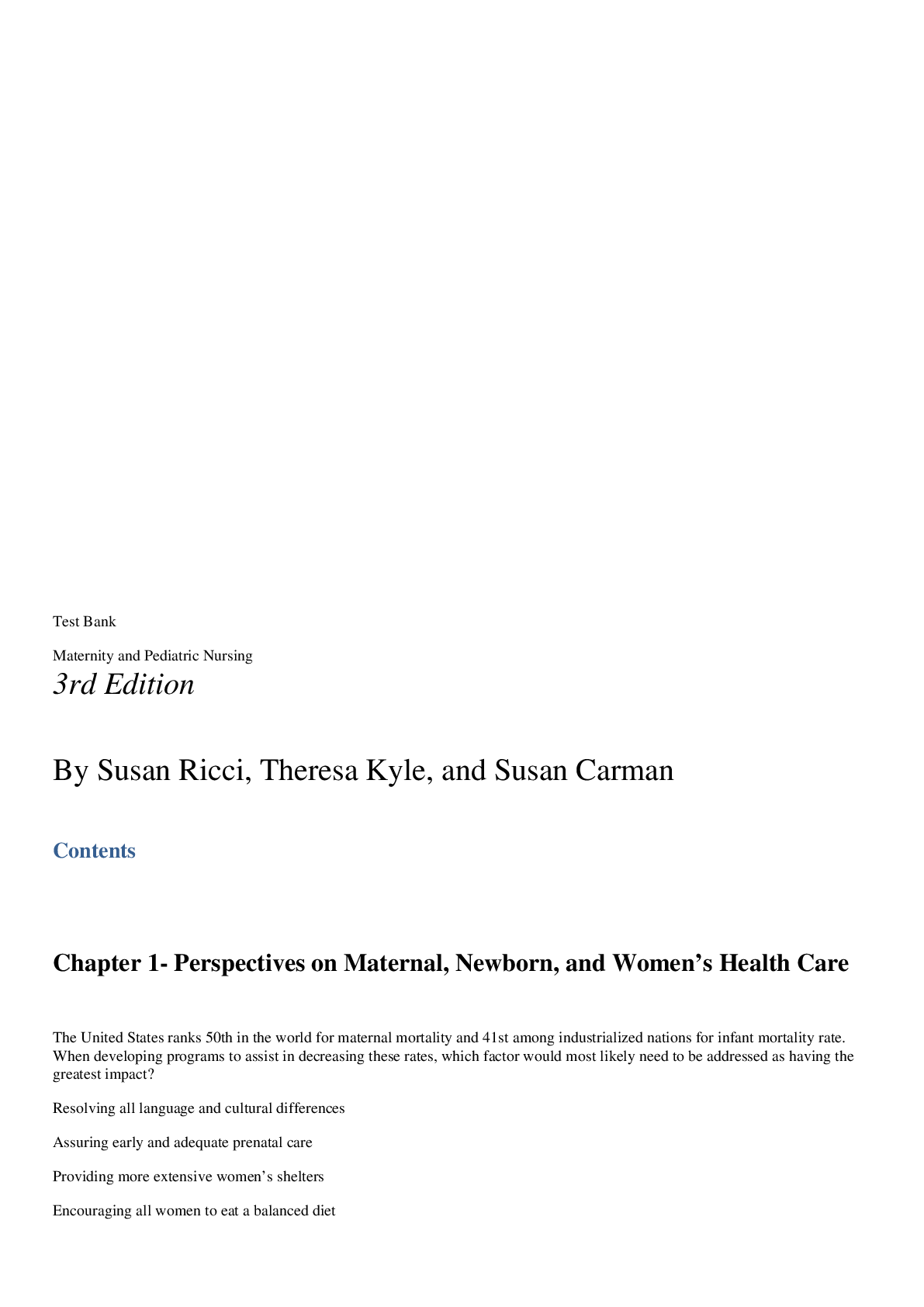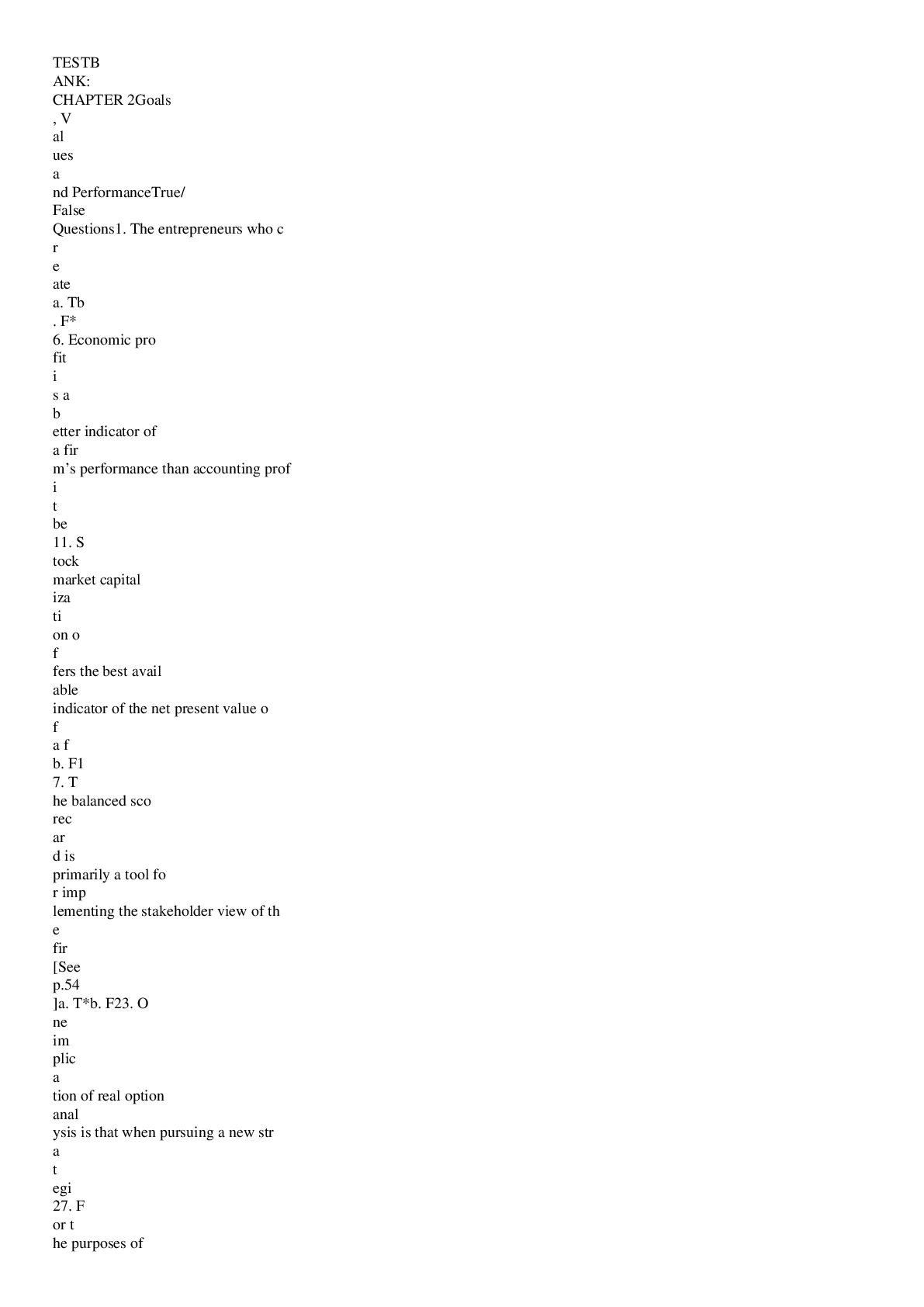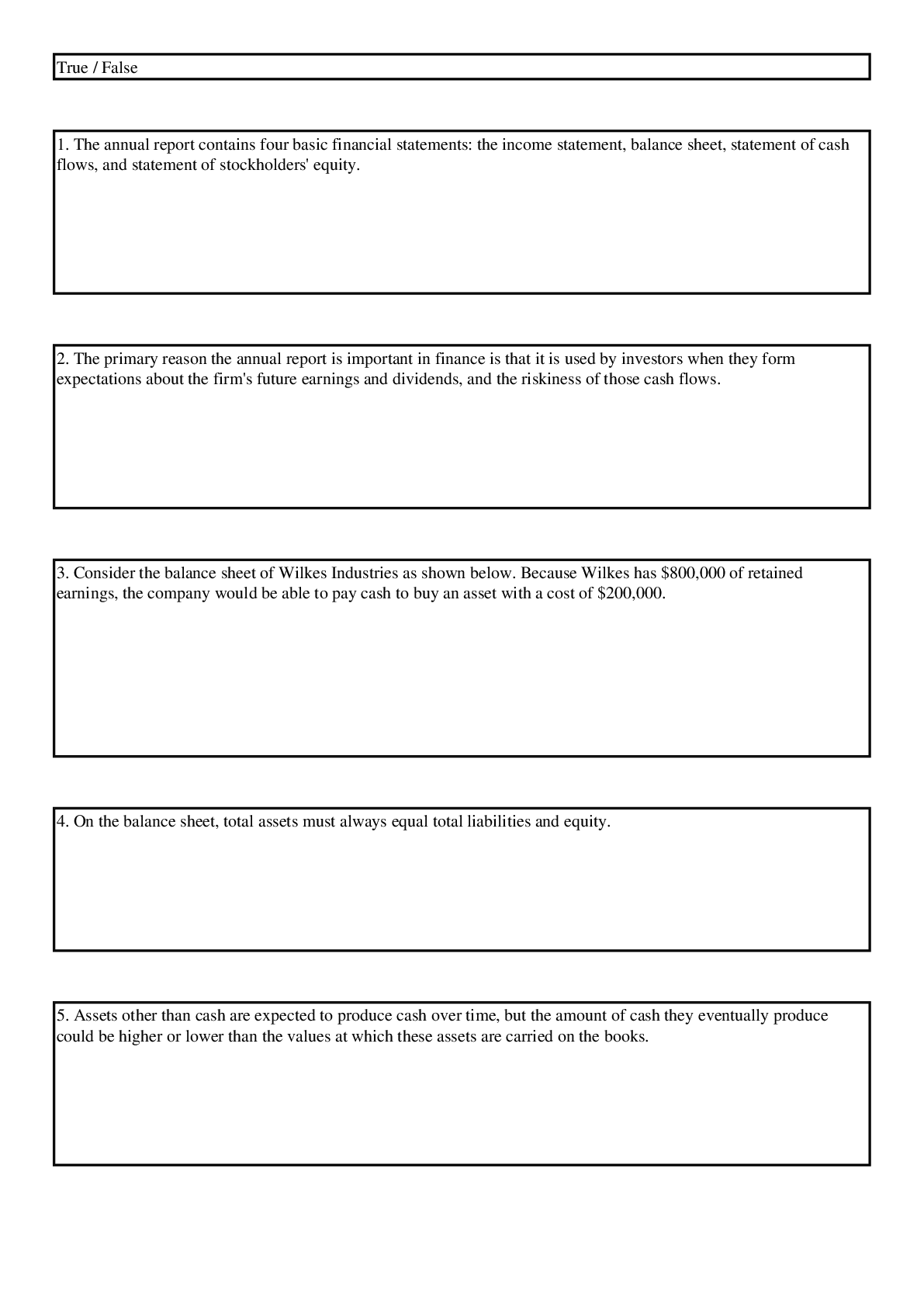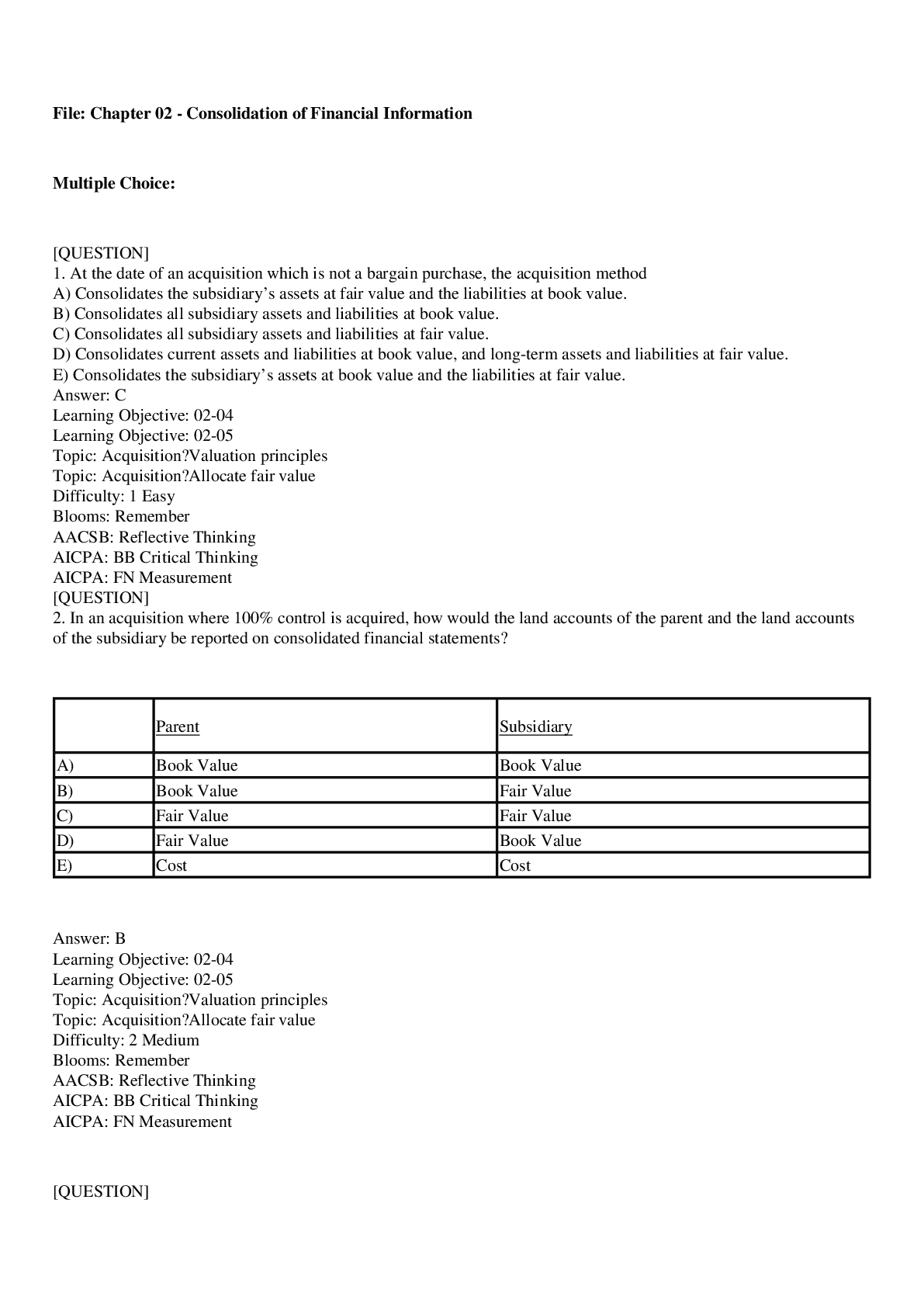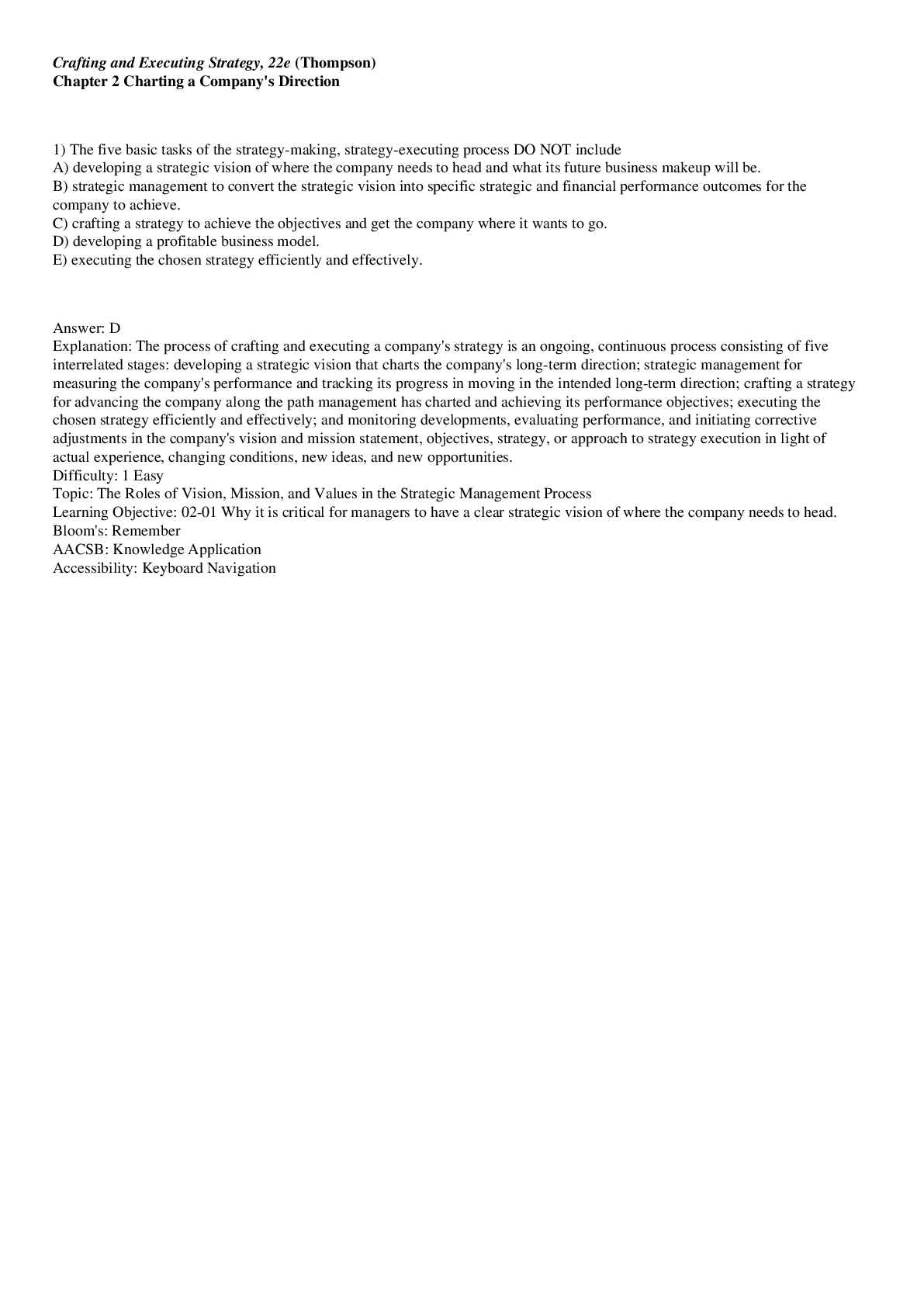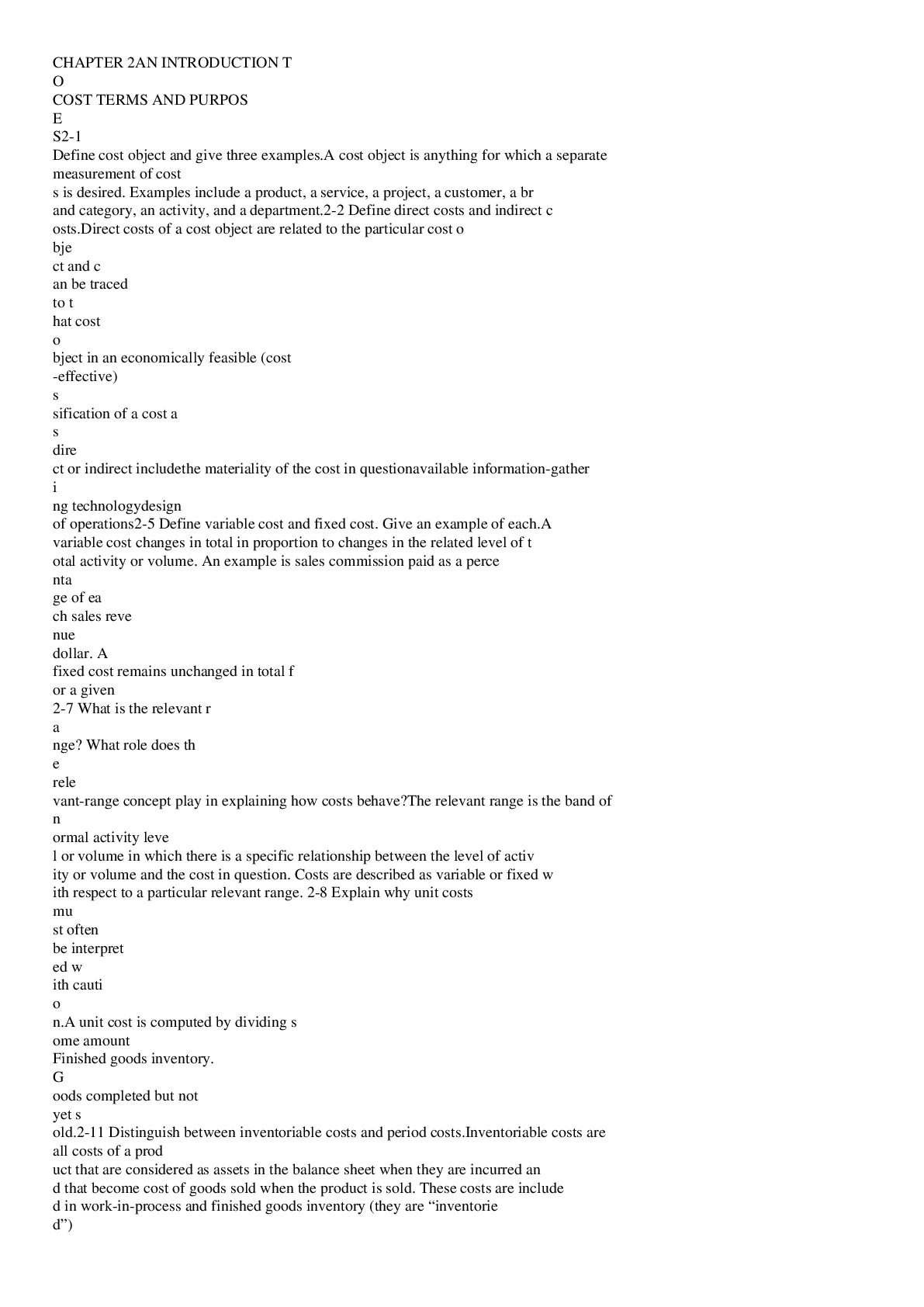Business Analytics > TEST BANK > Test Bank Business Statistics and Analytics in Practice 9th Edition Bowerman (All)
Test Bank Business Statistics and Analytics in Practice 9th Edition Bowerman
Document Content and Description Below
Student name:__________ TRUE/FALSE - Write 'T' if the statement is true and 'F' if the statement is false. 1) A stem-and-leaf display is a graphical portrayal of a data set that shows the data set's... overall pattern of variation. ⊚ true ⊚ false 2) The relative frequency is the frequency of a class divided by the total number of measurements. ⊚ true ⊚ false 3) A bar chart is a graphic that can be used to depict qualitative data. ⊚ true ⊚ false 4) Stem-and-leaf displays and dot plots are useful for detecting outliers. ⊚ true ⊚ false 5) A scatter plot can be used to identify outliers. ⊚ true ⊚ false 6) When looking at the shape of the distribution using a histogram, a distribution is skewed to the right when the left tail is shorter than the right tail. ⊚ true ⊚ false 7) When we wish to summarize the proportion (or fraction) of items in a class, we use the frequency distribution for each class. ⊚ true ⊚ false 8) When establishing the classes for a frequency distribution, it is generally agreed that the more classes you use the better your frequency distribution will be. ⊚ true ⊚ false 9) The cumulative frequency for a class will always be at least as large as the cumulative frequency for any class with a smaller upper boundary. ⊚ true ⊚ false 10) A frequency table includes row and column percentages. ⊚ true ⊚ false 11) When constructing a graphical display that utilizes categorical data, classes that have frequencies of 5 percent or less are usually combined together into a single category. ⊚ true ⊚ false 12) In a Pareto chart, the bar for the "Other" category should be placed to the far left of the chart. ⊚ true ⊚ false 13) In the first step of setting up a Pareto chart, a frequency table should be constructed of the defects (or categories) in decreasing order of frequency. ⊚ true ⊚ false 14) It is possible to create different interpretations of the same graphical display by simply using different captions. ⊚ true ⊚ false 15) Beginning the vertical scale of a graph at a value different from zero can cause increases to look more dramatic. ⊚ true ⊚ false 16) A runs plot is a form of scatter plot. ⊚ true ⊚ false 17) The stem-and-leaf display is advantageous because it allows us to actually see the measurements in the data set. ⊚ true ⊚ false 18) Splitting the stems refers to assigning the same stem to two or more rows of the stem-and-leaf display. ⊚ true ⊚ false 19) When data are qualitative, the bars should never be separated by gaps. ⊚ true ⊚ false 20) Each stem of a stem-and-leaf display should be a single digit. ⊚ true ⊚ false 21) Leaves on a stem-and-leaf display should be rearranged so that they are in increasing order from left to right. ⊚ true ⊚ false 22) Gauges feature a single measure showing variation over time. ⊚ true ⊚ false 23) Data drill down is a form of data discovery. ⊚ true ⊚ false 24) Treemaps are used to compare multiple stem-and-leaf diagrams. ⊚ true ⊚ false 25) Sparklines always need to be displayed with either their axes or coordinates. ⊚ true ⊚ false 26) A bullet graph features a single measure and displays it as either a horizontal or vertical bar. ⊚ true ⊚ false 27) Key performance indicators are best represented by a data discovery method. ⊚ true ⊚ false 28) A treemap displays information as a series of clustered rectangles. ⊚ true ⊚ false 29) Sparklines are line charts and are often embedded with the text where they are being discussed. ⊚ true ⊚ false 30) An analytic dashboard presents both current and historical trends of a business’s key performance indicators. ⊚ true ⊚ false 31) If space is an issue when presenting analytic dashboard graphics, gauges should be used most frequently. ⊚ true ⊚ false MULTIPLE CHOICE - Choose the one alternative that best completes the statement or answers the question. 32) Which of the following is not a graphical tool for descriptive analytics (dashboards)? A) bullet graph B) sparkline C) raw data D) treemap E) gauge 33) A(n) ________ is a graphical presentation of the current status and historical trends of a business’s key performance indicators. A) frequency distribution B) histogram C) Pareto chart D) dashboard 34) As a business owner, I have requested my staff to develop a set of dashboards that can be used by the public to show wait time at each of my four local coffee shops at peak times during the day and whether the time is short, medium, or long. Which of the following graphical displays would be the best choice? A) bullet graph B) sparkline C) treemap D) gauges 35) Which of the following is the best analytic dashboard graphical method for visualizing hierarchical information? A) bullet graph B) sparkline C) treemap D) gauge 36) Which of the following tools used by graphical descriptive analytics will show variation over time? A) bullet graph B) sparkline C) treemap D) gauge 37) A(n) ________ is a graph of a cumulative distribution. A) histogram B) scatter plot C) ogive D) pie chart 38) ________ can be used to study the relationship between two variables. A) Cross-tabulation tables B) Frequency tables C) Cumulative frequency distributions D) Dot plots 39) Row or column percentages can be found in A) frequency tables. B) relative frequency tables. C) cross-tabulation tables. D) cumulative frequency tables. 40) All of the following are used to describe quantitative data except the ________. A) histogram B) stem-and-leaf chart C) dot plot D) pie chart 41) An unusually large or small observation separated from the rest of the data is a(n) ________. A) absolute extreme B) outlier C) mode D) quartile 42) Which of the following graphs is for qualitative data? A) histogram B) bar chart C) ogive plot D) stem-and-leaf 43) A plot that allows us to visualize the relationship between two variables is a(n) ________ plot. A) frequency B) scatter C) dot D) ogive 44) A stem-and-leaf display is best used to ________. A) provide a point estimate of the variability of the data set B) provide a point estimate of the central tendency of the data set C) display the shape of the distribution D) display a two-variable treemap. 45) Which of the following divides quantitative measurements into classes and graphs the frequency, relative frequency, or percentage frequency for each class? A) histogram B) dot plot C) stem-and-leaf display D) scatter plot 46) A ________ displays the frequency of each class with qualitative data and a ________ displays the frequency of each class with quantitative data. A) histogram, stem-and-leaf display B) bar chart, histogram C) scatter plot, bar chart D) stem-and-leaf, pie chart 47) A ________ shows the relationship between two variables. A) stem-and-leaf B) bar chart C) histogram D) scatter plot E) pie chart 48) A(n) ________ can be used to differentiate the "vital few" causes of quality problems from the "trivial many" causes of quality problems. A) histogram B) scatter plot C) pareto chart D) ogive plot E) stem-and-leaf display 49) ________ and ________ are used to describe qualitative (categorical) data. A) Stem-and-leaf displays, scatter plots B) Scatter plots, histograms C) Dot plots, bar charts D) Bar charts, pie charts E) Pie charts, histograms 50) Which one of the following graphical tools is used with quantitative data? A) bar chart B) histogram C) pie chart D) Pareto chart 51) When developing a frequency distribution, the class (group) intervals must be ________. A) large B) small C) integer D) nonoverlapping E) equal 52) Which of the following graphical tools is not used to study the shapes of distributions? A) stem-and-leaf display B) scatter plot C) histogram D) dot plot 53) All of the following are used to describe qualitative data except the ________. A) bar chart B) pie chart C) histogram D) Pareto chart 54) If there are 130 values in a data set, how many classes should be created for a frequency histogram? A) 4 B) 5 C) 6 D) 7 E) 8 55) If there are 120 values in a data set, how many classes should be created for a frequency histogram? A) 4 B) 5 C) 6 D) 7 E) 8 56) If there are 62 values in a data set, how many classes should be created for a frequency histogram? A) 4 B) 5 C) 6 D) 7 E) 8 57) If there are 30 values in a data set, how many classes should be created for a frequency histogram? A) 4 B) 5 C) 6 D) 7 E) 8 58) A CFO is looking at what percentage of a company's resources are spent on computing. He samples companies in the pharmaceutical industry and develops the following stem-and-leaf display (leaf unit = 0.1). 5 269 6 255568999 7 11224557789 8 001222458 9 02455679 10 1556 11 137 12 13 255 What is the approximate shape of the distribution of the data? A) normal B) skewed to the right C) skewed to the left D) bimodal E) uniform 59) A CFO is looking at what percentage of a company's resources are spent on computing. He samples companies in the pharmaceutical industry and develops the following stem-and-leaf display (leaf unit = 0.1). 5 269 6 255568999 7 11224557789 8 001222458 9 02455679 10 1556 11 137 12 13 255 What is the smallest percentage spent on R&D? A) 5.9 B) 5.6 C) 5.2 D) 5.02 E) 50.2 60) A CFO is looking at what percentage of a company's resources are spent on computing. He samples companies in the pharmaceutical industry and develops the following stem-and-leaf display (leaf unit = 0.1). 5 269 6 255568999 7 11224557789 8 001222458 9 02455679 10 1556 11 137 12 13 255 If you were creating a frequency histogram using these data, how many classes would you create? A) 4 B) 5 C) 6 D) 7 E) 8 61) A CFO is looking at what percentage of a company's resources are spent on computing. He samples companies in the pharmaceutical industry and develops the following stem-and-leaf display (leaf unit = 0.1). 5 269 6 255568999 7 11224557789 8 001222458 9 02455679 10 1556 11 137 12 13 255 What would be the class length used in creating a frequency histogram? A) 1.4 B) 8.3 C) 1.2 D) 1.7 E) 0.9 62) A CFO is looking at what percentage of a company's resources are spent on computing. He samples companies in the pharmaceutical industry and develops the following stem-and-leaf display (leaf unit = 0.1). 5 269 6 255568999 7 11224557789 8 001222458 9 02455679 10 1556 11 137 12 13 255 What would be the first class interval for the frequency histogram? A) 5.2<6.6 B) 5.2<6.0 C) 5.0<6.0 D) 5.0<6.4 E) 5.2<6.4 63) A company’s Chief Operating Officer (COO) keeps track of the mileage on her trips from her office at corporate headquarters to the company’s off-site manufacturing facility and its nearby suppliers. The stem-and-leaf display of the data for one year is below. 76 9 77 114 78 79 07 80 88 81 2 82 1 83 88 How many trips were used in this display? A) 7 B) 9 C) 10 D) 11 E) 12 64) A company’s Chief Operating Officer (COO) keeps track of the mileage on her trips from her office at corporate headquarters to the company’s off-site manufacturing facility and its nearby suppliers. The stem-and-leaf display of the data for one year is below. 76 9 77 114 78 79 07 80 88 81 2 82 1 83 88 In developing a histogram of these data, how many classes would be used? A) 4 B) 5 C) 6 D) 7 E) 8 65) A company’s Chief Operating Officer (COO) keeps track of the mileage on her trips from her office at corporate headquarters to the company’s off-site manufacturing facility and its nearby suppliers. The stem-and-leaf display of the data for one year is below. 76 9 77 114 78 79 07 80 88 81 2 82 1 83 88 What would be the class length for creating the frequency histogram? A) 14 B) 9 C) 27 D) 18 E) 23 66) A company collected the ages from a random sample of its middle managers, with the resulting frequency distribution shown below. Class Interval Frequency 20 to< 25 8 25 to< 30 6 30 to< 35 5 35 to< 40 12 40 to< 45 15 45 to< 50 7 What would be the approximate shape of the relative frequency histogram? A) symmetrical B) uniform C) linear D) skewed to the left E) skewed to the right 67) A company collected the ages from a random sample of its middle managers, with the resulting frequency distribution shown below. Class Interval Frequency 20 to< 25 8 25 to< 30 6 30 to< 35 5 35 to< 40 12 40 to< 45 15 45 to< 50 7 What is the relative frequency for the class with the greatest frequency? A) .132 B) .226 C) .231 D) .283 E) .288 68) A company collected the ages from a random sample of its middle managers, with the resulting frequency distribution shown below. Class Interval Frequency 20 to< 25 8 25 to< 30 6 30 to< 35 5 35 to< 40 12 40 to< 45 15 45 to< 50 7 What is the midpoint of the third class interval? A) 22.5 B) 27.5 C) 32.5 D) 37.5 E) 42.5 69) The general term for a graphical display of categorical data made up of vertical or horizontal bars is called a(n) ________. A) pie chart B) Pareto chart C) bar chart D) ogive plot 70) Pareto charts are frequently used to identify ________. A) random data B) the most common types of defects C) outliers that do not show up on a dot plot D) the cause for extreme skewness to the right 71) A graphical portrayal of a quantitative data set that divides the data into classes and gives the frequency of each class is a(n) ________. A) ogive plot B) dot plot C) histogram D) Pareto chart E) bar chart 72) The number of measurements falling within a class interval is called the ________. A) frequency B) relative frequency C) leaf D) cumulative sum 73) A relative frequency histogram having a longer tail to the right than to the left is said to be ________. A) skewed to the left B) normal C) a scatter plot D) skewed to the right 74) The proportion of measurements in a class is called the ________ of that class. A) frequency B) relative frequency C) leaf D) cumulative percentage 75) A histogram that has a longer tail extending toward larger values is ________. A) skewed to the left B) normal C) a scatter plot D) skewed to the right 76) A histogram that has a longer tail extending toward smaller values is ________. A) skewed to the left B) normal C) a scatter plot D) skewed to the right 77) A type of very simple graph that can be used to summarize a quantitative data set is a(n) ________. A) runs plot B) ogive plot C) dot plot D) pie chart 78) An example of manipulating a graphical display to distort reality is ________. A) starting the axes at zero B) making the bars in a histogram equal widths C) stretching the axes D) adding an unbiased caption 79) As a general rule, when creating a stem-and-leaf display, there should be ______ stem values. A) between 3 and 10 B) between 1 and 100 C) no fewer than 20 D) between 5 and 20 80) At the end of their final exam, 550 students answered an additional question in which they rated their instructor’s teaching effectiveness, with the following results. Student's Rating of Instructor Student's Final Grade Very or Somewhat Effective Very or Somewhat Ineffective A 190 85 B 75 120 C 20 17 D 9 18 F 1 15 What proportion of the students who rated their instructor as very or somewhat effective received a B or better in the class? A) 0.345 B) 0.254 C) 0.482 D) 0.898 E) 0.644 81) At the end of their final exam, 550 students answered an additional question in which they rated their instructor's teaching effectiveness, with the following results. Student's Rating of Instructor Student's Final Grade Very or Somewhat Effective Very or Somewhat Ineffective A 190 85 B 75 120 C 20 17 D 9 18 F 1 15 What proportion of the students who rated their instructor as very or somewhat effective received a C or lower in the class? A) 0.03 B) 0.06 C) 0.10 D) 0.13 E) 0.15 82) 822 recently purchased books were randomly selected from all recent book purchases over the Internet. The chart below shows the breakdown of the classification of the book type. What percentage of the books in the sample were either mystery or science fiction/fantasy? A) 18.61 B) 36.50 C) 17.88 D) 24.33 E) 22.99 83) 822 recently purchased books were randomly selected from all recent book purchases over the Internet. The chart below shows the breakdown of the classification of the book type. What percentage of the books in the sample were self-help books? A) 11.44 B) .1144 C) 1.82 D) 0.0182 E) 0.940 84) 822 recently purchased books were randomly selected from all recent book purchases over the Internet. The chart below shows the breakdown of the classification of the book type. What percentage of the books in the sample were in the top two categories? A) 22.99 B) 20.44 C) 4.50 D) 43.43 E) 0.4343 85) Using the following data, describe the shape of the data distribution. 1. 11.5 6. 13.7 11. 11.0 16. 14.5 2. 13.5 7. 14.0 12. 13.0 17. 15.5 3. 12.5 8. 12.0 13. 16.7 18. 13.0 4. 15.2 9. 12.7 14. 12.5 19. 18.2 5. 14.7 10. 12.5 15. 11.5 20. 11.7 A) skewed to the left B) bimodal C) normal D) skewed to the right 86) Using the following data, what would be the range of the values of the stem in a stem-and-leaf display? 1. 11.5 6. 13.7 11. 11.0 16. 14.5 2. 13.5 7. 14.0 12. 13.0 17. 15.5 3. 12.5 8. 12.0 13. 16.7 18. 13.0 4. 15.2 9. 12.7 14. 12.5 19. 18.2 5. 14.7 10. 12.5 15. 11.5 20. 11.7 A) 11-17 B) 11-18 C) 10-18 D) 12-17 E) 12-18 87) Using the following data, what would be the leaf unit in a stem-and-leaf display? 1. 11.5 6. 13.7 11. 11.0 16. 14.5 2. 13.5 7. 14.0 12. 13.0 17. 15.5 3. 12.5 8. 12.0 13. 16.7 18. 13.0 4. 15.2 9. 12.7 14. 12.5 19. 18.2 5. 14.7 10. 12.5 15. 11.5 20. 11.7 A) 1.0 B) 10 C) .10 D) .01 E) .20 88) Consider the following data on distances traveled by people to visit the local amusement park and calculate the relative frequency for the shortest distance. Distance Frequency 1-8 miles 15 9-16 miles 12 17-24 miles 7 25-32 miles 5 33-40 miles 1 A) .375 B) .150 C) .500 D) .300 E) .333 89) Consider the following data on distances traveled by people to visit the local amusement park and calculate the relative frequency for the distances over 24 miles. Distance Frequency 1-8 miles 15 9-16 miles 12 17-24 miles 7 25-32 miles 5 33-40 miles 1 A) .375 B) .150 C) .125 D) .025 E) .325 90) The following is a partial relative frequency distribution of grades in an introductory statistics course. Grade Relative Frequency A 0.22 B ? C 0.18 D 0.17 F 0.06 Find the relative frequency for the B grade. A) .78 B) .27 C) .65 D) .37 E) .47 91) The following is a relative frequency distribution of grades in an introductory statistics course. Grade Relative Frequency A 0.22 B ? C 0.18 D 0.17 F 0.06 If this was the distribution of 200 students, find the frequency for the highest two grades. A) 44 B) 118 C) 59 D) 74 E) 35 92) The following is a relative frequency distribution of grades in an introductory statistics course. Grade Relative Frequency A 0.22 B ? C 0.18 D 0.17 F 0.06 If this was the distribution of 200 students, find the frequency of failures. A) 12 B) 6 C) 23 D) 46 E) 3 93) The following is a relative frequency distribution of grades in an introductory statistics course. Grade Relative Frequency A 0.22 B ? C 0.18 D 0.17 F 0.06 If we wish to depict these data using a pie chart, find how many degrees should be assigned to the highest grade of A. A) 61.1 B) 22.0 C) 79.2 D) 90.0 E) 212.40 94) Recently an advertising company called 200 people and asked them to identify the company that was in an ad running nationwide. The following results were obtained. Female Male Total Correctly recalled the company 66 50 116 Incorrectly recalled the company 44 40 84 Total 110 90 200 What percentage of those surveyed were female and could not recall the company? A) 40.0 B) 22.0 C) 52.4 D) 66.7 E) 37.9 95) Recently an advertising company called 200 people and asked them to identify the company that was in an ad running nationwide. The following results were obtained. Female Male Total Correctly recalled the company 66 50 116 Incorrectly recalled the company 44 40 84 Total 110 90 200 What percentage of those surveyed could not correctly recall the company? A) 58.00 B) 56.89 C) 55.00 D) 43.10 E) 42.00 96) A local electronics retailer recently conducted a study on purchasers of large screen televisions. The study recorded the type of television and the credit account balance of the customer at the time of purchase. They obtained the following results. Credit Balance LED LCD Plasma Projection Under $200 10 16 40 5 $200 — $800 8 12 24 15 Over $800 16 12 16 30 Total 34 40 80 50 What percentage of purchases were plasma televisions by customers with the smallest credit balances? A) 50.0 B) 39.2 C) 56.3 D) 34.8 E) 19.6 97) A local electronics retailer recently conducted a study on purchasers of large screen televisions. The study recorded the type of television and the credit account balance of the customer at the time of purchase. They obtained the following results. Credit Balance LED LCD Plasma Projection Under $200 10 16 40 5 $200 — $800 8 12 24 15 Over $800 16 12 16 30 Total 34 40 80 50 What percentage of the customers had the highest credit balances and purchased an LCD television? A) 36.3 B) 5.9 C) 19.6 D) 56.3 E) 16.2 98) The number of weekly sales calls by a sample of 25 pharmaceutical salespersons is below. 24, 56, 43, 35, 37, 27, 29, 44, 34, 28, 33, 28, 46, 31, 38, 41, 48, 38, 27, 29, 37, 33, 31, 40, 50 How many classes should be used in the construction of a histogram? A) 4 B) 6 C) 10 D) 5 E) 2 99) The number of weekly sales calls by a sample of 25 pharmaceutical salespersons is below. 24, 56, 43, 35, 37, 27, 29, 44, 34, 28, 33, 28, 46, 31, 38, 41, 48, 38, 27, 29, 37, 33, 31, 40, 50 What is the shape of the distribution of the data? A) skewed to the right B) skewed to the left C) normal D) bimodal 100) The number of items rejected daily by a manufacturer because of defects for the last 30 days are: 20, 21, 8, 17, 22, 19, 18, 19, 14, 17, 11, 6, 21, 25, 4, 19, 9, 12, 16, 16, 10, 28, 24, 6, 21, 20, 25, 5, 17, 8 How many classes should be used in constructing a histogram? A) 6 B) 5 C) 7 D) 4 E) 8 ESSAY. Write your answer in the space provided or on a separate sheet of paper. 101) The number of weekly sales calls by a sample of 25 pharmaceutical salespersons is below. 24, 56, 43, 35, 37, 27, 29, 44, 34, 28, 33, 28, 46, 31, 38, 41, 48, 38, 27, 29, 37, 33, 31, 40, 50Construct an ogive of the weekly sales calls. 102) The number of items rejected daily by a manufacturer because of defects for the last 30 days are: 20, 21, 8, 17, 22, 19, 18, 19, 14, 17, 11, 6, 21, 25, 4, 19, 9, 12, 16, 16, 10, 28, 24, 6, 21, 20, 25, 5, 17, 8 Complete this frequency table for these data. Frequency Rel Freq Cum Freq 4 < 9 9 < 14 14 < 19 19 < 24 24 < 29 103) The number of items rejected daily by a manufacturer because of defects for the last 30 days are: 20, 21, 8, 17, 22, 19, 18, 19, 14, 17, 11, 6, 21, 25, 4, 19, 9, 12, 16, 16, 10, 28, 24, 6, 21, 20, 25, 5, 17, 8 Construct a stem-and-leaf display. 104) The number of items rejected daily by a manufacturer because of defects for the last 30 days are: 20, 21, 8, 17, 22, 19, 18, 19, 14, 17, 11, 6, 21, 25, 4, 19, 9, 12, 16, 16, 10, 28, 24, 6, 21, 20, 25, 5, 17, 8 Construct an ogive of the number of items rejected daily. 105) Consider the following data. 1. 11.5 6. 13.7 11. 11.0 16. 14.5 2. 13.5 7. 14.0 12. 13.0 17. 15.5 3. 12.5 8. 12.0 13. 16.7 18. 13.0 4. 15.2 9. 12.7 14. 12.5 19. 18.2 5. 14.7 10. 12.5 15. 11.5 20. 11.7 Create a stem-and-leaf display for the sample. 106) Consider the following data on distances traveled by people to visit the local amusement park. Distance Frequency 1-8 miles 15 9-16 miles 12 17-24 miles 7 25-32 miles 5 33-40 miles 1 Construct an ogive that corresponds to the frequency table. 107) The following is a relative frequency distribution of grades in an introductory statistics course. Grade Relative Frequency A 0.22 B 0.37 C 0.18 D 0.17 F 0.06 If this was the distribution of 200 students, give the frequency distribution for this data. 108) The following is a relative frequency distribution of grades in an introductory statistics course. Grade Relative Frequency A 0.22 B 0.37 C 0.18 D 0.17 F 0.06 Construct a percent bar chart for this data. 109) The following is a relative frequency distribution of grades in an introductory statistics course. Grade Relative Frequency A 0.22 B 0.37 C 0.18 D 0.17 F 0.06 If we wish to depict these data using a pie chart, find how many degrees (out of 360 degrees) should be assigned to each grade. 110) Fill in the missing components of the following frequency distribution constructed for a sample size of 50. Class Frequency Rel Frequency Cum Rel Freq ___ < 7.95 0.12 ___ < 8.05 0.48 8.05 < ___ 0.24 ___<8.25 0.10 8.25 < ___ 111) Recently an advertising company called 200 people and asked them to identify the company that was in an ad running nationwide. They obtained the following results. Female Male Total Correctly recalled the company 66 50 116 Incorrectly recalled the company 44 40 84 Total 110 90 200 Construct a table of row percentages. 112) Recently an advertising company called 200 people and asked them to identify the company that was in an ad running nationwide. They obtained the following results. Female Male Total Correctly recalled the company 66 50 116 Incorrectly recalled the company 44 40 84 Total 110 90 200 Construct a table of column percentages. 113) A local electronics retailer recently conducted a study on purchasers of large screen televisions. The study recorded the type of television and the credit account balance of the customer at the time of purchase. They obtained the following results. Construct a table of row percentages. 114) A local electronics retailer recently conducted a study on purchasers of large screen televisions. The study recorded the type of television and the credit account balance of the customer at the time of purchase. They obtained the following results. Construct a table of column percentages. 115) Math test anxiety can be found throughout the general population. A study of 116 seniors at a local high school was conducted. The following table was produced from the data. Complete the missing parts. 116) The number of weekly sales calls by a sample of 25 pharmaceutical salespersons is below. 24, 56, 43, 35, 37, 27, 29, 44, 34, 28, 33, 28, 46, 31, 38, 41, 48, 38, 27, 29, 37, 33, 31, 40, 50 Construct a histogram. 117) The number of weekly sales calls by a sample of 25 pharmaceutical salespersons is below. 24, 56, 43, 35, 37, 27, 29, 44, 34, 28, 33, 28, 46, 31, 38, 41, 48, 38, 27, 29, 37, 33, 31, 40, 50 Construct a stem-and-leaf plot. 118) The number of weekly sales calls by a sample of 25 pharmaceutical salespersons is below. 24, 56, 43, 35, 37, 27, 29, 44, 34, 28, 33, 28, 46, 31, 38, 41, 48, 38, 27, 29, 37, 33, 31, 40, 50 Construct a frequency polygon. 119) The following table lists the types of customer complaint calls on satellite TV service during the first two months after installation. No signal detected 20 % Can't receive local channels 14 % Missing channels 21 % Intermittent reception 8 % Remote control problems 25 % Other issues 12 % Construct a Pareto chart. 120) The following data consist of the number of sick days taken by the 100 employees at a small manufacturing company for the past 18 months. Construct a dot plot of these data and describe the distribution. 5, 1, 4, 8, 0, 6, 3, 5, 3, 4, 7, 15, 5, 8, 2, 1, 5, 4 Answer Key Test name: ch2 1) TRUE 2) TRUE 3) TRUE 4) TRUE 5) FALSE 6) TRUE 7) FALSE 8) FALSE 9) TRUE 10) FALSE 11) TRUE 12) FALSE 13) TRUE 14) TRUE 15) TRUE 16) TRUE 17) TRUE 18) TRUE 19) FALSE 20) FALSE 21) TRUE 22) FALSE 23) TRUE 24) FALSE 25) FALSE 26) TRUE 27) FALSE 28) TRUE 29) TRUE 30) TRUE 31) FALSE 32) C 33) D 34) A 35) C 36) B 37) C 38) A 39) C 40) D 41) B 42) B 43) B 44) C 45) A 46) B 47) D 48) C 49) D 50) B 51) D 52) B 53) C 54) E 55) D 56) C 57) B 58) B 59) C 60) C 61) A 62) A 63) E 64) A 65) D 66) D 67) D 68) C 69) C 70) B 71) C 72) A 73) D 74) B 75) D 76) A 77) C 78) C 79) D 80) D 81) C 82) B 83) A 84) D 85) D 86) B 87) C 88) A 89) B 90) D 91) B 92) A 93) C 94) B 95) E 96) E 97) B 98) D 99) A 100) B 101) %media:image058.png% Create a frequency table with cumulative relative frequency and then construct the graph using the cumulative frequency points. Classes Frequency RelFreq Cum RelFreq 24 < 31 7 0.28 0.28 31 < 38 8 0.32 0.60 38 < 45 6 0.24 0.84 45 < 52 3 0.12 0.96 52 < 57 1 0.04 1.00 102) Classes Frequency RelFreq Cum RelFreq 4 < 9 6 0.2 0.2 9 < 14 4 0.133 0.333 14 < 19 7 0.233 0.567 19 < 24 9 0.30 0.867 24 < 29 4 0.133 1.00 The Cum Freq column should be .566, .866, and 0.999. The values listed do not add to 1.00 exactly due to rounding.Using the given classes, frequency = number of rejected items in each class, relative frequency = frequency/30, and cumulative frequency = sum of successive class relative frequencies. 103) One possible stem-and-leaf display (with each stem split into five): Stem Leaf 0 45 0 66 0 889 1 01 1 2 1 4 1 66777 1 8999 2 00111 2 2 2 455 2 2 8 A second possible stem-and-leaf display (with each stem split into two): Stem Leaf 0 4 0 566889 1 0124 1 66777899 2 0011124 2 558 Stem should be the 10s unit. Construct by splitting stems, since the range of values is only 5-28 and there should be approximately 10 stems. When splitting the stem, consider the number of values in the split stems. Leaf unit should be the ones unit. 104) %media:capture3graph_jpg.ext% Construct a frequency table (5 classes) with cumulative relative frequency. Classes Frequency RelFreq Cum RelFreq 4 < 9 6 0.20 0.20 9 < 14 4 0.13 0.33 14 < 19 7 0.23 0.57 19 < 24 9 0.30 0.87 24 < 29 4 0.13 1.00 105) One possible stem-and-leaf display as might be created by Minitab:Stem-and-leaf of given data, N = 20, Leaf Unit = 0.10 4 11 0 5 5 7 9 12 0 5 5 5 7 (4) 13 0 0 5 7 7 14 0 5 7 4 15 2 5 2 16 7 1 17 1 18 2 Stems should be from 11 to 18; leaves are the tenth unit. 106) %media:image078.png% Calculate the relative frequency for each class (15/40, 12/40, 7/40, 5/40, 1/40; or .375, .30, .175, .125, and .025) and then the cumulative frequency (.375, .675, .850, .975, 1.00). 107) Grade Relative Frequency A 44 B 74 C 36 D 34 F 12 Convert from proportion (relative frequency) to frequency by multiplying each relative frequency by 200 (e.g., .22 × 200 = 44 for grade A). 108) %media:image086.png% Each grade category is displayed as a bar on a percent bar chart. 109) Grade Relative Frequency A 79.2 B 133.2 C 64.8 D 61.2 F 21.6 Each proportion (relative frequency) is considered that portion of a circle's 360 degrees. Multiply the relative frequency (proportion) by 360 to convert to actual circle degrees (e.g., grade A: .22 × 360 = 79.2 degrees). 110) Class Frequency Rel Frequency Cum Rel Freq 7.85 < 7.95 6 0.12 0.12 7.95 < 8.05 18 0.36 0.48 8.05 < 8.15 12 0.24 0.72 8.15 < 8.25 5 0.10 0.82 8.25 < 8.35 9 0.18 1.00 <br>Work each row to generate the missing frequency and/or relative frequency given a sample size of 50. For example, first class: cum rel freq = rel freq = x/50 = 0.12, so x = 6. Complete the class interval by recognizing that the second class beginning boundary is the end of the first interval's boundary and using the class length calculated in the second class (0.10) to apply to all other classes. 111) Female Male Total Correctly recalled the company 56.9 % 43.1 % 100.0 % Incorrectly recalled the company 52.4 % 47.6 % 100.0 % <br> Row percentages are calculated by dividing each part of the row by the total of the row and multiplying by 100. For example, Female and correctly recalled = 66, which yields a row percentage of (66/116)*100 = 56.9%. 112) Female Male Correctly recalled the company 60.0 % 55.6 % Incorrectly recalled the company 40.0 % 44.4 % Total 100.0 % 100.0 % <br> Column percentages are calculated by dividing each part of the column by the total of the column and multiplying by 100. For example, Female and correctly recalled = 66, which yields a column percentage of (66/110)*100 = 60.0%. 113) Credit Balance LED LCD Plasma Projection Total Under $200 (10/71)*100 = 14.1% (16/71)*100 = 22.5% (40/71)*100 = 56.3% (5/71)*100 = 7.0% 100.0% $200—$800 (8/59)*100 = 13.6% (12/59)*100 = 20.3% (24/59)*100 = 40.7% (15/59)*100 = 25.4% 100.0% Over $800 (16/74)*100 = 21.6% (12/74)*100 = 16.2% (16/74)*100 = 21.6% (30/74)*100 = 40.5% 100.0% Row percentages are calculated by dividing each part of the row by the total of the row and multiplying by 100. Need to calculate the totals for each row (under $200 = 71; $200-$800 = 59; over $800 = 74). For example, credit balance under $200 and LCD TV = 16, which yields row percentage (16/71)*100 = 22.5%. 114) Credit Balance LED LCD Plasma Projection Under $200 29.4 % 40.0 % 50.0 % 10.0 % $200—$800 23.5 % 30.0 % 30.0 % 30.0 % Over $800 47.1 % 30.0 % 20.0 % 60.0 % Total 100.0 % 100.0 % 100.0 % 100.0 % Column percentages calculated by dividing each part of the column by the total of the column and multiplying by 100. For example, credit balance under $200 and LCD TV = 16 yields row percentage (16/40)*100 =40.0%. 115) [Show More]
Last updated: 1 year ago
Preview 1 out of pages

Buy this document to get the full access instantly
Instant Download Access after purchase
Add to cartInstant download
We Accept:

Reviews( 0 )
$10.00
Document information
Connected school, study & course
About the document
Uploaded On
May 01, 2021
Number of pages
Written in
Additional information
This document has been written for:
Uploaded
May 01, 2021
Downloads
0
Views
4

